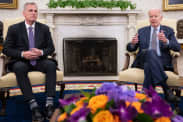The 2-year Treasury yield jumped for a 12th straight session on Friday, extending its longest streak of advances in more than five years, after an uptick in the Federal Reserve’s favorite inflation gauge boosted the likelihood of a June rate hike.
What happened
-
The yield on the 2-year Treasury
TMUBMUSD02Y,
4.564% jumped 7.9 basis points to 4.587% from 4.508% on Thursday. It’s up for 12 straight trading days, the longest such streak since January 2018. For the week, the yield rose 30 basis points, its largest weekly gain since September, based on 3 p.m. Eastern time figures from Dow Jones Market Data. -
The yield on the 10-year Treasury
TMUBMUSD10Y,
3.756% rose less than 1 basis point to 3.820% from 3.814% late Thursday. It’s up 10 of the past 11 sessions. For the week, the 10-year rate rose 13 basis points. - Friday’s levels were the highest for the 2- and 10-year yields since March 9.
-
The yield on the 30-year Treasury
TMUBMUSD30Y,
3.906% was 3.974%, down 2.9 basis points from 4.003% Thursday afternoon. For the week, it rose 2.8 basis points. - Trading in Treasurys ended early in the U.S. on Friday ahead of the Memorial Day weekend.
What drove markets
Data released on Friday showed inflation as measured by the Fed’s preferred inflation measure, the PCE price index, stuck in the 4%-5% range for April. The yearly increase in prices rose to 4.4% from 4.2% in the prior month, and the narrower core rate edged up to 4.7% from 4.6% over the past 12 months.
Fed-funds-futures traders boosted the likelihood, as of late Friday afternoon, that the Federal Reserve will lift rates again by another quarter of a percentage point in June to 66.5%. That’s up from 51.7% a day ago. Such a raise would take the Fed’s main benchmark rate target to 5.25-5.5%, according to the CME FedWatch Tool. Traders also factored in a 24.7% chance of another hike of the same size in July.
In Friday’s other data releases, consumer spending jumped 0.8% in April — the biggest increase in three months — as Americans bought more new cars and other goods and increased outlays on services.
In debt-ceiling developments, President Joe Biden and House Speaker Kevin McCarthy were said to be closing in on a deal to raise the government’s $31.4 trillion debt ceiling for two years while capping spending on most items. However, a deputy for McCarthy described the talks as “up and down.”
Rates on T-bills maturing in early June have dropped dramatically on optimism about a debt-ceiling deal. The yield on the 3-month bill issued on March 2 and maturing on June 1 was 5.812% as of 2 p.m. Eastern time, down 144.2 basis points since Wednesday’s close of 7.254%, according to Tradeweb.
What analysts are saying
“Coming back from Memorial Day weekend, the tone of the market is likely going to be dictated by the state of the debt-ceiling negotiations,” said Thomas Simons, U.S. economist at Jefferies. “As of Friday, it looks like the two sides are getting close to a deal, but progress can reverse quickly. Should a deal come together, it is likely that Treasury will flood the market with Treasury bill issuance as soon as next week.”






